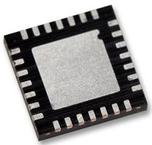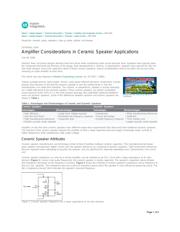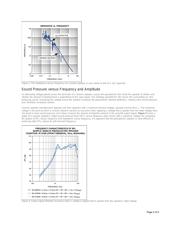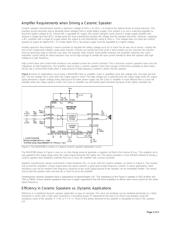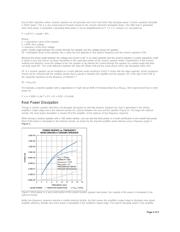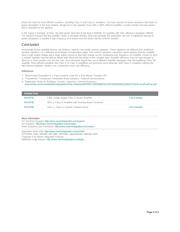下载

Attend this brief webcast by Maxim on
TechOnline
Maxim > Design Support > Technical Documents > Tutorials > Amplifier and Comparator Circuits > APP 4164
Maxim > Design Support > Technical Documents > Tutorials > Audio Circuits > APP 4164
Keywords: ceramic, piezo, speakers, class g, audio, cellular, cell phones
TUTORIAL 4164
Amplifier Considerations in Ceramic Speaker Applications
Feb 05, 2008
Abstract:
New cell phone designs
demand small form factor while maintaining audio sound-pressure level. Speakers have typically been
the component that limits the thinness of the design. New developments in ceramic, or piezoelectric, speakers have opened the door for
new sleek designs. Due to the capacitive nature of these ceramic speakers, special considerations need to be taken into account when
choosing an audio amplifier to drive them.
This article was also featured in Maxim's Engineering Journal, vol. 62 (PDF, 1.3MB).
Today's portable devices need smaller, thinner, more power-efficient electronic components. Cellular
phones have become so thin that the dynamic speaker is now the limiting factor in how thin
manufacturers can make their handsets. The ceramic, or piezoelectric, speaker is quickly emerging
as a viable alternative to the dynamic speaker. These ceramic speakers can deliver competitive
sound-pressure levels (SPLs) in a thin and compact package, thus potentially replacing traditional
voice-coil dynamic speakers. Some of the differences between dynamic and ceramic speakers are
shown in Table 1.
Table 1. Advantages and Disadvantages of Ceramic and Dynamic Speakers
Ceramic Speakers Dynamic Speakers
Advantages Disadvantages Advantages Disadvantages
• High efficiency
• Very thin form factor
• Tight manufacturing tolerances
• Smaller acoustic cavity required
• Large drive voltage required
• Restricted low-frequency
response
• Capacitive load
• Inexpensive
• Proven technology
• Smooth frequency response
• Wide manufacturing tolerances
• Inefficient
• Thick solution size
• Larger acoustic cavity required
Amplifier
circuits that drive ceramic speakers have different output-drive requirements than those that drive traditional dynamic speakers.
The structure of the ceramic speaker requires the amplifier to drive a large capacitive load and supply increasingly larger currents at
higher frequencies while maintaining a high output voltage.
Ceramic Speaker Attributes
Ceramic speaker manufacturers use technology similar to that of building multilayer ceramic capacitors. This manufacturing technique
gives speaker manufacturers tighter control over the speaker tolerances as compared to dynamic speakers. Tight construction tolerances
become important when attempting to equalize the speaker, and are significant for obtaining repeatable sonic characteristics from unit to
unit.
Ceramic speaker impedance, as seen by a driving amplifier, can be modeled as an RLC circuit with a large capacitance as its main
element (Figure 1). Across most audio frequencies, the ceramic speaker is mostly capacitive. The speaker's capacitive nature dictates
that impedance decreases as the frequency increases. Figure 2 shows the similarity of ceramic speaker's impedance versus frequency to
that of a 1µF capacitor. This impedance also has a point of resonance above which the speaker is most efficient at producing sound. The
dip in impedance around 1kHz indicates the speaker's resonant frequency.
Figure 1. Ceramic speaker impedance has a large capacitance as its main element.
Page 1 of 5

